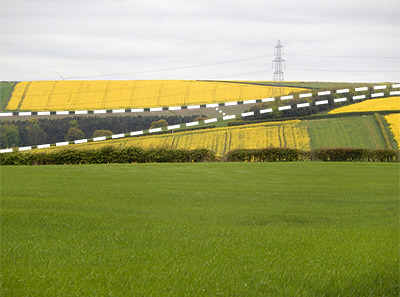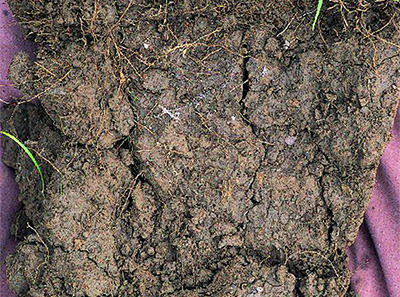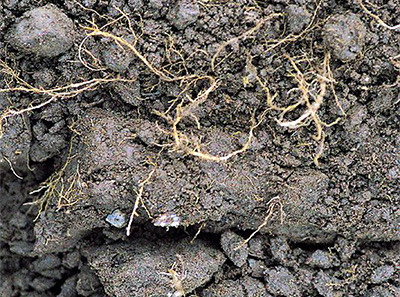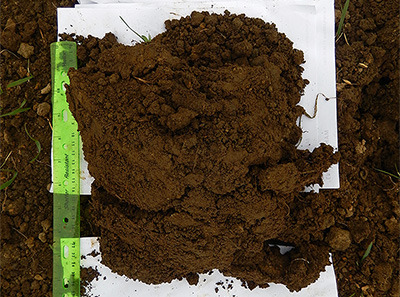CAVERTI Tool
Slope
Slope is a baseline risk factor for soil erosion occurring as result of heavy rainfall events; in general steeper longer slopes are more susceptible to soil erosion. Whilst you are unable to alter field slope in order to reduce this risk, this tab aims to help indicate the susceptibility of land to soil erosion based upon gradient and length of slope.
In the tick boxes provided:
Please select the slope type (A - D) that currently resembles your land of interest. As slope cannot be altered, please repeat your 'current' answer for your potential scenario.
Soil Type
Soil type can be a major limiting factor in the type of crop that can be grown on land, the rate at which rain water infiltrates through the soil, and how easily soil can be detached and moved via runoff. Whilst you are unlikely to be able to alter the soil type, this tab aims to help indicate the susceptibility of different soil types to erosion as a result of heavy rainfall events.
In the tick boxes provided:
Please select the most widespread soil type (A - D) currently in your land of interest. As soil type cannot be altered, please repeat your 'current' answer for your potential scenario.
(Image source: www.soil-net.com - please see credits).
Soil Structure
Soil structure can greatly influence the risk of soil erosion occurring as a result of heavy rainfall events. Soils with a poor structure, such as compacted, poorly aerated soils are more likely to be prone to waterlogging. As rainwater cannot readily infiltrate through compacted soil, soil erosion and runoff is more likely to occur.
In the tick boxes provided:
Please select the soil structure (A - D) that currently represents your land of interest. If there is 'potential' to improve soil structure on your land select the lower risk option that applies.
(If a lower risk option is not applicable simply repeat your current answer for your potential scenario).
Crop Cover
A well-established crop can help protect the soil surface from rain drops which detach soil from the land during heavy rainfall events. Crops also provide a rough surface to help slow down any runoff that may arise, helping soil deposit back on the land. The roots of crops also help bind soil together improving soil structure and stability.
In the tick boxes provided:
Please select the crop cover option (A - D) that 'currently' resembles your land of interest and a 'potential' lower risk option you might consider for that location.
(If a lower risk option is not applicable simply repeat your current answer for your potential scenario).
Tramlines
For sloping fields, the risk of soil erosion occurring as a result of heavy rainfall events is greatly increased under the up-downslope formation of tramlines; bare soil in these tramlines is particularly susceptible to rill formation. Rills are small channels that form on the soil surface when sediment is detatched by runoff; these channels act as a pathway to move soil down slope and can be the predominant source of soil lost from sloping fields in heavy rainfall events.
In the tick boxes provided:
Please select the tramline arrangement (A - D) that 'currently' resembles your land of interest and a ‘potential’ lower risk option you might consider for that location. [If your land is level please select from options C or D only].
(If a lower risk option is not applicable simply repeat your current answer for your potential scenario).
Gateway Position
Heavy traffic accessing gateways has the potential to create bare soil at field entrances, resulting in poor ground condition. Gateways located adjacent to main roads and surface water drainage systems at the base of sloping fields are likely to be at higher risk for conveying runoff, resulting in sedimentation and flooding. It may be worth considering whether gateway position can be altered to reduce risk and/or improve surfacing at access points to minimise the creation of bare soil and wheel ruts.
In the tick boxes provided:
Please select the gateway description (A - D) that 'currently' resembles your field of interest, and a ‘potential’ lower risk option you might aim for.
(If a lower risk option is not applicable simply repeat your current answer for your potential scenario).
NOTE: If your land is level, please select from the options C or D only.
Land Drainage
Maintaining land drains, ditches and pipe outlets can help ensure the field drainage system is working efficiently; where soils are saturated and rainwater can not infiltrate through the soil, the risk of surface water runoff and soil erosion occurring in heavy rainfall events is likely to be higher.
In the tick boxes provided:
Please select the land drainage characteristic (A - D) that currently resembles your field of interest and a 'potential' lower risk option you might work towards for that location.
(If a lower risk option is not applicable simply repeat your current answer for your potential scenario).
Field Boundaries
Maintaining field boundaries and enhancing those across slopes is likley to help reduce the risk of soil erosion occurring as a result of heavy rainfall events; well planned and maintained field boundaries with few gaps can help intercept and slow the rate of runoff, reduce soil loss and aid deposition within the field boundary.
In the tick boxes provided:
Please select the field boundary (A - D) that currently resembles your land of interest, and a 'potential' lower risk option you might consider for that location. [If you have a variety of field boundary types, select the boundary type most commonly found across slopes, if you have sloping land].
(If a lower risk option is not applicable simply repeat your current answer for your potential scenario).
Risk Summary
The risk summary bar below compares the overall risk of soil erosion occurring in heavy rainfall events based on the answers you provided.
Is your potential risk lower than your current risk?
The table below presents a breakdown of your results, illustrating where risk can be reduced (e.g. High to Medium).
These are your priority areas to target interventions.
Look up advice on the Interventions tab to identify measures you could take to reduce risk in relation to these factors.
Interventions
The table below lists key risk factors for soil erosion occurring in heavy rainfall event.
Follow the links provided to guidance and see examples of measures, to help you select appropriate interventions for your land of interest.
To further support the value of taking these proactive steps to keep soils on land and slow the rate of runoff, please note the case-studies page illustrates the relatively high-cost of erosion associated impacts on infrastructure; proactive investment in relatively low-cost interventions could significantly reduce the need for the relatively high cost, reactive management illustrated by the case studies.
| Risk Factor | Interventions to help mitigate risk of soil erosion and erosion-associated risks to infrastructure |
|---|---|
| Slope |
As you can not alter slope, manage other risks factors where possible, especially where your baseline risk of erosion is high owing to a relatively steep or long slope.
|
| Soil Type |
As you can not alter soil type, manage other risk factors where possible, especially where your baseline risk of erosion is high owing to a heavy clay or very light sandy and loamy soils. Check the optimum cropping regime for your soil type: |
| Soil Structure |
Avoid soil compaction by using dual or flotation tyres on farm vehicles to help spread the load over a large area. To encourage topsoil stability apply organic manures; avoid over-deep working of the land and over-deep cultivation. Use minimal cultivation techniques for susceptible soils e.g. by ploughing and rolling in one operation with the crop sown at right-angles to the direction of rolling. A variety of manuals are available to help assess your soil structure and optimise soil organic matter which can improve drainage and crop yields. For guidance and links to other information see: |
| Crop Cover |
Limit the area and duration for which the soil surface is left bare over winter by sowing autumn crops; sow crops early to help them establish and form deeper roots. Sowing winter cover crops can help minimise the risk of nitrate leaching and also help imrpove soil fertility. Incorporate conservation management in your crop cover choice: If an area is particularly susceptible to soil erosion and can not be improved by changes in husbandry or cropping, consider sowing permanent grass or planting a woodland. Help towards costs of planting and materials may be available from the Woodland Trust Morewoods scheme or from the Forestry Commission through Countryside Stewardship woodland capital grants: |
| Tramlines |
If safe to do so (in relation to the risk of farm vehicles tipping), carry out cultivations that will create tramlines across slope, avoiding the creation of up/downslope tramlines. Avoid access when the soil is wet. Shift the tramline pattern to avoid repeat compaction of land in tramlines / tracks. |
| Gateways |
If road safety and security requirements are met, situate gateways at the top of any sloping fields. Also consider surfacing access gateways with hardcore and filling in wheel ruts. If a site is particularly susceptible to runoff consider installing a sediment trap to collect surface water and intercept soil: Install interceptor ditches (silt traps) to channel surface water away from areas prone to erosion (e.g. areas frequently accessed by farm machinery, and at the base of long steep slopes) or away from areas with connectivity to water courses, roads or drains (e.g. potentially at gateways). |
| Drainage |
Identify areas where drainage efficiency could be improved: Follow best practice guidelines for maintaining field drains, ditches and outlets in efficient working condition to minimise ponding and runoff: Reduce runoff by increasing surface drainage by using subsoilers or mole ploughs. Consider constructing a farm wetland to manage runoff, protect the water environment and improve ecological condition: |
| Boundaries |
Where possible, plant up field boundaries with hedges which when established and if well maintained, help increase infiltration rates, slow runoff and intercept soil: Use permanent grass buffer strips both within fields and between fields to reduce field erosion, and alongisde ponds or water courses to help intercept sediments and nutrients or pesticides. Encourage regeneration of trees and shrubs to stabilise borders adjacent to flowing water. |































